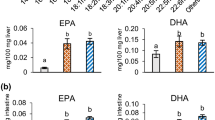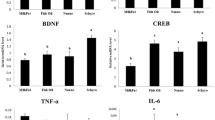Abstract
Biomass of the acidophilic green alga Coccomyxa onubensis may be used as a food source for animals without collateral toxic effects, as diet supplemented the microalga has significant hypoglycemic and hypocholesterolemic effects on healthy animals. Rats were fed for 108 days with a high-fat diet, and at the end of the experiment, they were overweight and had significantly increased serum levels of glucose (2.0-fold), total cholesterol (1.6-fold), and low-density lipoprotein (LDL)-cholesterol (7.7-fold). The supplement of C. onubensis powder (6.25% w/w dry weight) in the high-fat diet significantly protected the rats against cardiovascular risks by reducing the serum levels of glucose (38.47%), total cholesterol (22.65%), and LDL-cholesterol (26.70%). The protective effects of the microalga were comparable with that of 10 mg/kg body weight per day of atorvastatin. The high-fat diet decreased both ω–3 eicosapentaenoic and docosahexaenoic acids in the brain tissue of rats; however, C. onubensis powder could not restrict these changes. Simultaneously, the high-fat diet increased the levels of both palmitic and arachidonic (ω–6) acids in the telencephalon tissue of rats; this was prevented when microalga biomass was used in the diet of rats.



Similar content being viewed by others
References
Amine H, Benomar Y, Haimeur A, Messaouri H, Meskini N, Taouis M (2016) Odontella aurita-enriched diet prevents high fat diet-induced liver insulin resistance. J Endocrinol 228:1–12
Bermejo E, Ruiz-Domínguez MC, Cuaresma M, Vaquero I, Ramos-Merchante A, Vega JM, Vílchez C, Garbayo I (2018) Production of lutein, and polyunsaturated fatty acids by the acidophilic eukaryotic microalga Coccomyxa onubensis under abiotic stress by salt or ultraviolet light. J Biosci Bioeng 125:669–675
Bishop WM, Zubeck HM (2012) Evaluation of microalgae for use as nutraceuticals and nutritional supplements. J Nutr Food Sci 2:147
Chen J, Jiang Y, Ma K-Y, Chen F, Chen Z-Y (2011) Microalga decreases plasma cholesterol by down-regulation of intestinal NPC1L1, hepatic LDL receptor, and HMG-CoA reductase. J Agric Food Chem 59:6790–6797
Crespo MJ, Quidgley J (2015) Simvastatin, atorvastatin, and pravastatin equally improve the hemodynamic status of diabetic rats. World J Diabetes 6:1168–1178
Deng R, Chow T-J (2010) Hypolipidemic, antioxidant, and anti-inflammatory activities of microalgae Spirulina. Cardiovasc Ther 28:e33–e35
Dvir I, Stark AH, Chayoth R, Madar Z, Arad SM (2009) Hypocholesterolemic effects of nutraceuticals produced from the red microalga Porphyridium sp. in rats. Nutrients 1:156–167
Fedorova I, Salem N Jr (2006) Omega-3 fatty acids and rodent behavior. Prostaglandins Leukot Essent Fat Acids 75:271–289
Folch J, Lees M, Sloane-Stanley GH (1957) A simple method for the isolation and purification of total lipids from animal tissues. J Biol Chem 226:497–509
Forján E, Navarro F, Cuaresma M, Vaquero I, Ruiz-Domínguez MC, Gojkovic Z, Vázquez M, Márquez M, Mogedas B, Bermejo E, Girlich S, Domínguez MJ, Vílchez C, Vega JM, Garbayo I (2015) Microalgae: fast-growth sustainable green factories. Crit Rev Environ Sci Technol 45:1705–1755
Freeman LR, Haley-Zitlin V, Rosenberger DS, Granholm AC (2014) Damaging effects of a high-fat diet to the brain and cognition: a review of proposed mechanisms. Nutr Neurosci 17:241–251
Giménez da Silva L, Masetto M, Mori MA, Biesdorf de Almeida C, Visentainer JV, Carbonera F, Rabello A, Nunes L, Massao S, Curi R, Barbosa R (2018) Brain fatty acids composition and inflammatory in mice fed with high-carbohydrate diet or high-fat diet. Nutrients 10(9):1277
Gómez-Zorita S, Trepiana J, González-Arceo M, Aguirre L, Milton-Leskibar I, González M, Eseberri I, Fernández-Quintela A, Portillo MP (2020) Anti-obesity effects of microalgae. Int J Mol Sci 21(1):41
Graziani G, Schiavo S, Nicolai MA, Buono S, Fogliano V, Pinto G, Pollio A (2013) Microalgae as human food: chemical and nutritional characteristics of the thermo-acidophilic microalga Galdieria sulphuraria. Food Funct 4:144–152
Grundy SM, Brewer HB Jr, Cleeman JI, Smith SC Jr, Lenfant C, American Heart Association; National Heart, Lung, and Blood Institute (2004) Definition of metabolic syndrome: report of the National Heart, Lung, and Blood Institute/American Heart Association conference on scientific issues related to definition. Circulation 109:433–438
Haag M (2003) Essential fatty acids and the brain. Can J Psychiatr 48:195–203
Haimeur A, Mimouni V, Ulmann L, Martineau AS, Messaouri H, Pineau-Vincent F, Trenblin G, Meskini N (2016) Fish oil and microalgae omega-3 as dietary supplements: a comparative study risk factors in high-fat fed rats. Lipids 51:1037–1049
Hua P, Yu Z, Xiong Y, Zhao L (2018) Regulatory efficacy of Spirulina platensis protease hydrolysate on lipid metabolism and gut microbiota in high-fat diet-fed rats. Int J Mol Sci 19(12):4023
Kanoski SE, Davidson TL (2011) Western diet consumption and cognitive impairment: Links to hippocampal dysfunction and obesity. Physiol Behav 103:59–68
Kohsaka A, Laposky AD, Ramsey KM, Estrada C, Joshu C, Kobayashi Y, Turek FW, Bass J (2007) High-fat diet disrupts behavioral and molecular circadian rhythms in mice. Cell Metab 6:414–421
Kumar SA, Magnusson M, Ward LC, Paul NA, Brown L (2015) A green algae mixture of Scenedesmus and Schroederiella attenuates obesity-linked metabolic syndrome in rats. Nutrients 7:2771–2787
Li T-T, Liu Y-Y, Wan X-Z, Huang Z-R, Liu B, Zhao C (2018) Regulatory efficacy of the polyunsaturated fatty acids from microalgae Spirulina platensis on lipid metabolism and gut microbiota in high-fat diet rats. Int J Mol Sci 19:3075
Liptak B, Knezl V, Gasparova Z (2019) Anti-arrhythmic and cardio-protective effect of atorvastatin and a potent pyrido-indole derivative on isolated hearts from rats with metabolic syndrome. Bratisl Lek Listy 120:200–206
Liu H-C, Chang C-J, Yang T-H, Chiang M-T (2017) Long-term feeding of red algae (Gelidium amansii) ameliorates glucose and lipid metabolism in a high fructose diet-impaired glucose tolerance rat model. J Food Drug Anal 25:543–549
Matos J, Cardoso C, Bandarra NM, Afonso C (2017) Microalgae as healthy ingredients for functional food: a review. Food Funct 8:2672–2685
Mayer C, Come M, Ulmann L, Zittelli GC, Faraloni C, Nazih H, Ouguerram K, Chénais B, Mimouni V (2019) Preventive effects of the marine microalga Phaeodactylum tricornutum, used as a food supplement, on risk factors associated with metabolic syndrome in Wistar rats. Nutrients 11(5):1069
Melo HM, Santos LE, Ferreira ST (2019) Diet-derived fatty acids, brain inflammation, and mental health. Front Neurosci 13:265
Moon ML, Joesting JJ, Lawson MA, Chiu GS, Blevins NA, Kwakwa KA, Freund GG (2014) The saturated fatty acid, palmitic acid, induces anxiety-like behavior in mice. Metabolism 63:1131–1140
Nasirian F, Sarir H, Moradikor N (2019) Antihyperglycemic and antihyperlipidemic activities of Nannochloropsis oculata microalgae in streptozotocin-induced diabetic rats. BioMol Concepts 10:37–43
Navarro F, Forján E, Vázquez M, Montero Z, Bermejo E, Castaño MA, Toimil A, Chaguaceda E, García-Sevillano MA, Sánchez M, Domínguez MJ, Pásaro R, Garbayo I, Vílchez C, Vega JM (2016) Microalgae as a safe food source for animals: nutritional characteristics of the acidophilic microalga Coccomyxa onubensis. Food Nutr Res 60. https://foodandnutritionresearch.net/index.php/fnr/article/view/974
Nazih H, Bard J-M (2018) Microalgae in human health: interest as a functional food. In: Levine IA, Fleurence J (eds) Microalgae in health and disease prevention. Elsevier, Amsterdam, pp 211–226
Pan Y-Y, Zeng F, Guo W-L, Li T-T, Jia R-B, Huang Z-R, Lv X-C, Zhang J, Liu B (2018) Effect of Grifola frondosa 95% ethanol extract on lipid metabolism and gut microbiota composition in high-fat diet-fed rats. Food Funct 9:6268–6278
Paseban M, Mohebbati R, Niazmand S, Sathyapalan T, Sahebkar A (2019) Comparison of the neuroprotective effects of aspirin, atorvastatin, captopril and metformin in Diabetes mellitus. Biomolecules 9(4):118
Patil NK, Le V, Sligar AD, Mei L, Chavarria D, Yang EY, Baker AB (2018) Algal polysaccharides as therapeutic agents for atherosclerosis. Frontiers Card Med 5:153
Perona JS, Portillo MP, Macarulla MT, Tueros AI, Ruiz-Gutiérrez V (2000) Influence of different dietary fats on triacylglycerol deposition in rat adipose tissue. Br J Nutr 84:765–774
Rapoport SI, Rao J, Igarashi M (2007) Brain metabolism of nutritionally essential polyunsaturated fatty acids depends on both the diet and the liver. Prostaglandins Leukot Essent Fat Acids 77:251–261
Raposo MF, de Morais AM, de Morais RM (2015) Marine polysaccharides from algae with potential biomedical applications. Mar Drugs 13:2967–3028
Ryan AS, Bailey-Hall E, Nelson EB, Salem N Jr (2009) The hypolipidemic effect of an ethyl ester of algal-docosahexaenoic acid in rats fed a high-fructose diet. Lipids 44:817–826
Rzymski P, Jaskiewicz M (2017) Microalgal food supplements from the perspective of Polish consumers: pattern of use, adverse events, and beneficial effects. J Appl Phycol 29:1841–1850
Sathasivam R, Radhakrishnan R, Hashem A, Abd_Allah EF (2019) Microalgae metabolites: a rich source for food and medicine. Saudi J Biol Sci 26:709–722
Sklayen MG (2018) The global epidemic of the metabolic syndrome. Curr Hypertens Rep 20(2):812
Spencer SJ, Korosi A, Laye S, Shukkit-Hale B, Barrientos RM (2017) Food for thought: how nutrition impacts cognition and emotion. Scienc Food 1:7
Valentini KJ, Pickens CA, Wiesinger JA, Fenton JI (2018) The effect of fish oil supplementation on brain DHA and EPA content and fatty acid profile in mice. Int J Food Sci Nutr 69:705–717
Wan X-Z, Li T-T, Zhong R-T, Chen H-B, Xia X, Gao L-Y, Gao X-X, Liu B, Zhang H-Y, Zhao C (2019) Anti-diabetic activity of PUFAs-rich extract of Chlorella pyrenoidosa and Spirulina platensis in rats. Food Chem Toxycol 128:233–239
Werman MJ, Sukenik A, Mokady S (2003) Effect of the marine unicellular alga Nanochloropsis sp. to reduce the plasma and liver cholesterol levels in male rats fed on diets with cholesterol. Biosci Biotechnol Biochem 67:2266–2268
Winocur G, Greenwood CE (2005) Studies of the effects of high fat diets on cognitive function in a rat model. Neurobiol Aging 26:46–49
Yang T-H, Yao H-T, Chiang M-T (2017) Red algae (Gelidium amansii) hot water extract ameliorates lipid metabolism in hamsters fed a high-fat diet. J Food Drug Anal 25:931–938
Funding
This study is funded by the University of Huelva and Andalusian Government (research project BIO–214).
Author information
Authors and Affiliations
Corresponding author
Ethics declarations
Conflict of interest
The authors declare they have no conflict of interest.
Additional information
Publisher’s note
Springer Nature remains neutral with regard to jurisdictional claims in published maps and institutional affiliations.
Rights and permissions
About this article
Cite this article
Navarro, F., Toimil, A., Ramírez, S. et al. The acidophilic microalga Coccomyxa onubensis and atorvastatin equally improve antihyperglycemic and antihyperlipidemic protective effects on rats fed on high-fat diets. J Appl Phycol 32, 3923–3931 (2020). https://doi.org/10.1007/s10811-020-02280-4
Received:
Revised:
Accepted:
Published:
Issue Date:
DOI: https://doi.org/10.1007/s10811-020-02280-4




